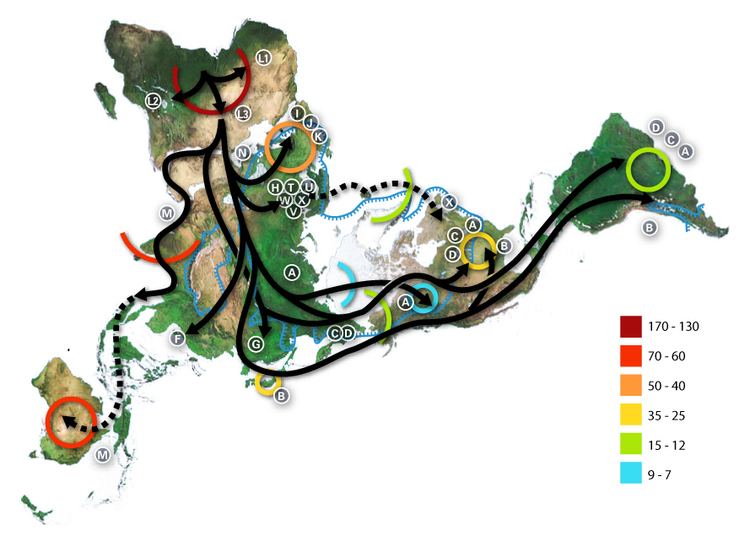Possible time of origin 40,000 ± 10,000 YBP Ancestor N | Possible place of origin Asia Descendants A3, A4, A5, A7, A8 | |
 | ||
Defining mutations 152, 235, 523-524d, 663, 1736, 4248, 4824, 8794, 16290, 16319 | ||
In human mitochondrial genetics, Haplogroup A is a human mitochondrial DNA (mtDNA) haplogroup.
Contents
Origin
Haplogroup A is believed to have arisen in Asia some 30,000–50,000 years before present. Its ancestral haplogroup was Haplogroup N.
Its highest frequencies are among Indigenous peoples of the Americas, its largest overall population is in East Asia, and its greatest variety (which suggests its origin point) is in East Asia. Thus, it might have originated in and spread from the Far East.
Distribution
Its subgroup A2 (actually a subclade of A4, which is widespread in Asia) is found in Chukotko–Kamchatka and is also one of five mtDNA haplogroups found in the indigenous peoples of the Americas, the others being B, C, D, and X.
Haplogroup A2 is the most common haplogroup among the Inuit, Na-Denes, and many Amerind ethnic groups of North and Central America. Lineages belonging to haplogroup A2 also comprise the majority of the mtDNA pool of the Inuit and their neighbors, the Chukchis, in northeasternmost Siberia.
Other branches of haplogroup A are less frequent but widespread among other populations of Asia. In particular, haplogroup A4(xA2) is ubiquitous in populations from Siberia in the north to Iran and Vietnam in the south. Haplogroup A5, on the other hand, is rather limited to populations from Korea and Japan southward, though it has been detected as singletons in a pair of large samples of Khamnigans (1/99 = 1.0%) and Buryats (1/295 = 0.3%) from the Buryat Republic.
In Asia, A(xA2) is especially frequent in Tibeto-Burman-speaking populations of Southwest China, such as Tibetans (6/65 = 9.2%, 25/216 = 11.6%, 11/73 = 15.1%). Approximately 7% to 15% of Koreans belong to haplogroup A. Approximately 5% to 12% of the Japanese belong to haplogroup A (including A4, A5, and A(xA4, A5)). Approximately 4% to 13% of Mongols belong to haplogroup A, almost all of whom are contained within the A4 subclade (2/47 = 4.3% Mongolians from Ulan Bator in haplogroup A4, 4/48 = 8.3% Mongols from New Barag Left Banner in haplogroup A(xA5), 6/47 = 12.8% Mongolians from Ulan Bator in haplogroup A4). Approximately 3% to 9% of Chinese people belong to haplogroup A. Haplogroup A also has been found in Vietnamese (2/42 = 4.8%, including one A4 and one A5(xA5a)). Approximately 4% (3/71) of Tatars from Aznakayevo, 3% (4/126) of Tatars from Buinsk, and 2% of Turkish people belong to haplogroup A. Haplogroup A4 has been found in 2.4% (2/82) of a sample of Persians from eastern Iran and in 2.3% (1/44) of a sample of Tajiks from Tajikistan. Haplogroup A is not found among Austronesians.
Tree
This phylogenetic tree of haplogroup A subclades is based on the paper by Mannis van Oven and Manfred Kayser Updated comprehensive phylogenetic tree of global human mitochondrial DNA variation and subsequent published research.
Popular culture
The mummy "Juanita" of Peru, also called the "Ice Maiden", has been shown to belong to mitochondrial haplogroup A.
In his popular book The Seven Daughters of Eve, Bryan Sykes named the originator of this mtDNA haplogroup Aiyana.
Eva Longoria, an American actress of Mexican descent is Haplogroup A2.
